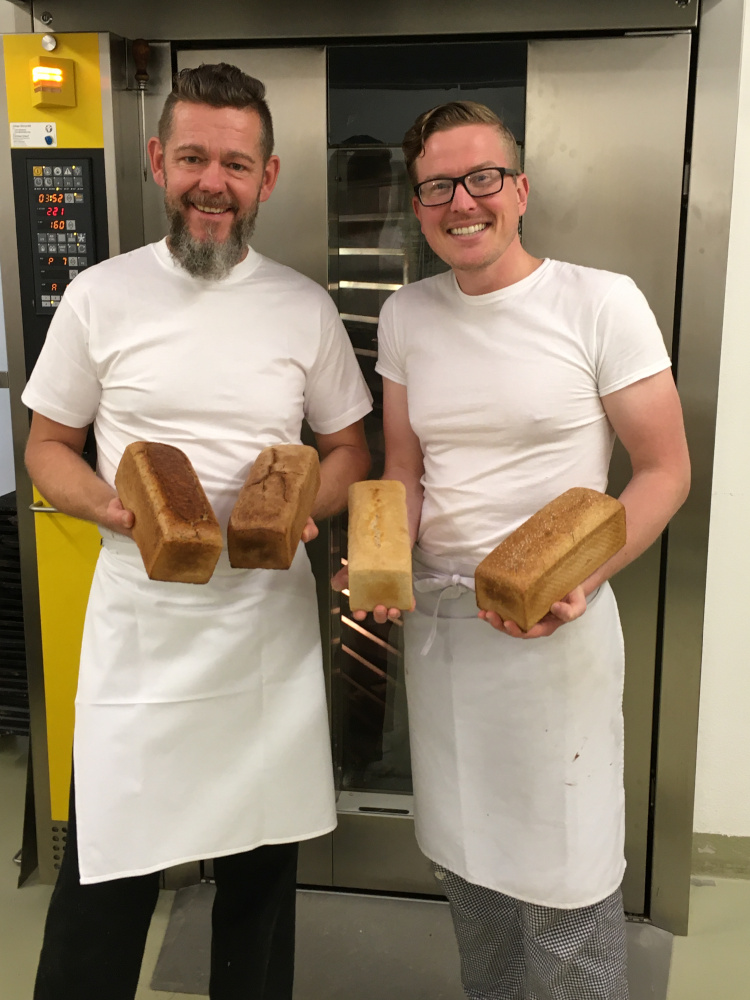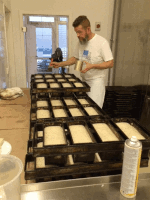A World of Gluten-Free Baked Goods

Throughout the baker training process, we discussed how to best utilized gluten in creating baked goods. Gluten is a protein structure that will trap gas produced during the fermentation process. This gas build-up is responsible for the bread rising. As bakers, we are responsible for ensuring that this gluten is well formed, not over worked, and optimally structured. However, it is estimated that 0.75 percent of the population has celiac disease, an autoimmune response to gluten consumption.
I set off to Glauchau in the neighboring state of Saxony to learn a bit more about the process of producing breads, rolls, cookies, and Stollen without the help of gluten. Does one use yeast if that CO2 is not able to be trapped in the dough? How does the product taste when using alternative flours? Does one have to knead the dough?
I arrived by train and was picked up at the platform by possibly the most friendly baker in Germany. I had gotten in contact with him through Dumbledore. The baker had invited me to spend a week working with him in his bakery and staying with him in his home. In our earlier phone conversations, he was excited to share his time and knowledge with me and I was excited to see his part of the world.

We immediately headed off to the bakery where he could show me around while it was quiet. He pointed out a machine that was engineered for gluten-free purposes. I was familiar with the machine as it is what is used in butcher shops: a vacuum filler. He was impressed; this was off to a good start.
We headed to his house and he showed me where I would be staying. Dinner was almost ready. I was informed that this was a Christian household and we would be praying before our two daily meals. I had no qualms; I could roll with anything. It did, however, take me two meals before I remembered to hold off on putting something on my plate until after the prayers.
The next day, we were off to the bakery at 3 AM using his eBikes. It was a frosty week in November, so this was a bit uncomfortable. At this time, I was not too interested in electric bicycles, but I will admit that I am now a fan. The extra oomph when climbing hills or in a strong wind is much appreciated.
I have to admit that I was overwhelmed with the new information about water binding properties of alternative flours and starches, and how they form a mass under heat and their consistency while being mixed. I had thousands of questions. The first couple days were just taking it all in.
This was the first bakery where I have worked that did not have a sales area. There was no sales person nor customers coming in the door. The bakery itself was located in a commercial/industrial area and was built in a converted storage unit. They rely on a website where people with celiac, gluten alergies, or interest in such baked goods order various baked goods (and other third party products). The package pickup is around 3 PM, so our task was to bake the ordered products and have them cooled and packaged before pickup. This mean that there was no unsold products at the end of the day; no waste. Very cool process.
On Day Two, the baker had to spend some time in his office, so allowed me to experiment with the various flours and their binding qualities. I sought to find out how much water they would bind in order to form a good dough. Although it was something for me to do to kill time, it was an extremely helpful way to better understand these flours.
We also spent an evening on Day Three measuring the acidity of his sourdough. He uses a special form of sourdough called Backferment. It is derived from honey bacteria and can consumed non-gluten flour starches to produce carbon dioxide. It is much more fluid than ‘normal’ sourdough and does not taste as pungent. Like gluten sourdough, there are thousands of ways to prepare Backferment. I look forward to future experiments that I will pursuing in the future…
My time there ended on a Thursday morning, which was convenient for me as I had to teach tap that evening. Also, the bakery only operates Monday through Thursday, given delivery constraints for Fridays into Saturdays. We sat around the breakfast table and in his prayers, the baker requested that my goals and aspirations be filled and gave thanks for bringing us all together. He was quite emotional. I could only thank him for his prayers.
He provided me a large box of baked goods for me to try out at home. As we pulled away from the bakery, heading to the train station, his wife waved from the doorway with tears on her cheeks. The train was waiting as we arrived, although it did not pull out for another ten minutes. The baker kept a stiff upper lip as he brought me to the platform. We said a final farewell and he headed back to the bakery.
This four-day internship provided me more insights and follow-up questions than any other. It was a very different world than baking with gluten. Although, the theory needed for a quality gluten product is the same for gluten-free, it is the ingredients that throw a wrinkle in the process. This experience definitely made up for that last one…





